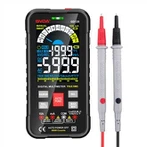Use of microscope eyepieces and objectives
The use of a monocular microscope, to develop the habit of observing with the left eye, the observation of both eyes open at the same time, do not open a closed one, because it is easy to fatigue. In order to train students to get used to observing with both eyes open at the same time, you can cut a piece of rectangular cardboard about 14cm long and 6cm wide, dig a hole with a diameter slightly smaller than the outer diameter of the upper end of the lens barrel near the left end, set the hole in the upper section of the lens barrel, and open both eyes at the same time when observing, use the right end of the piece of paper to block the right eye's line of sight, and so the training for a period of time, you will be able to get used to the two eyes are open at the same time, and then remove the piece of paper. Then remove the piece of paper.
Straight microscope arm and mirror base connection, is a mechanical joint, can be used to adjust the tilt of the barrel, easy to observe, the arm can not be too backward tilt, generally not more than 40 °. But in the use of clinical film observation, prohibit the use of tilted joints (when the lens barrel tilted, the carrier platform is also tilted, the liquid on the slide is easy to flow), especially when the mount contains acidic reagents is strictly prohibited, in order to avoid contamination of the mirror body.
The use of eyepieces and objective lenses
Generally a moderate magnification of the eyepiece (10 ×) and * low-magnification objective lens to start observing, and gradually change to a higher magnification objective lens, from which to find the magnification in line with the experimental requirements.
When switching objectives, first observe with a low magnification objective and adjust to the correct working distance (imaging * clear). If you further observe with a high-magnification objective, you should move the part of the object image that needs to be magnified for observation to the centre of the field of view before converting the high-magnification objective (the range of the object image in the field of view is much reduced when you convert the low-magnification objective to a high-magnification objective for observation). Low-magnification objective and high-magnification objective is basically in focus (the same high focus), in the use of low-magnification objective observation is clear, change the high-magnification objective should be able to see the object image, but the object image is not necessarily very clear, you can turn the fine focusing screw to adjust.
It is generally accepted that when using any objective lens, the upper limit of effective magnification is 1,000 times its numerical aperture, and the lower limit is 250 times its numerical aperture. For example, if the numerical aperture of 40× objective lens is 0.65, the upper and lower limits are: 1000×0.65=650 times and 250×0.65≈163 times, respectively, and the upper limit of the effective magnification is called ineffective magnification, which can't improve the observation effect. Below the lower limit of magnification can not be distinguished by the human eye, is not conducive to observation. Generally* the practical magnification range is 500-700 times the number of numerical aperture between the figures.






